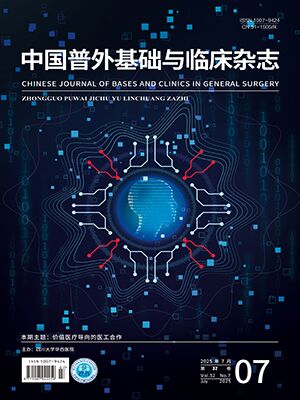| 1. |
杨威, 钟德金, 王力涛, 等. 血清PGE-2和血乳酸水平与急性上消化道出血病情严重程度及预后的相关性分析. 中国现代医学杂志, 2022, 32(19): 25-31.
|
| 2. |
倪志展, 王松, 朱俩辰, 等. 消化性溃疡穿孔修补术的远期疗效. 中华普通外科杂志, 2021, 36(1): 47-49.
|
| 3. |
Yang C, Cai L, Xiao SY. Pathologic characteristics of digestive tract and liver in patients with coronavirus disease 2019. Gastroenterol Clin North Am, 2023, 52(1): 201-214.
|
| 4. |
吕颜智, 周业江. 血清降钙素原对急性消化道穿孔部位的预测价值. 中华急诊医学杂志, 2021, 30(11): 1353-1357.
|
| 5. |
张静, 何涛, 刘茗. 消化性溃疡患者血清MCP-1水平变化及其对并发上消化道出血的预测效能. 山东医药, 2022, 62(11): 84-86.
|
| 6. |
董焕乐, 李杨雪. 雷贝拉唑联合碱性抗酸药对消化道溃疡患者胃黏膜的保护效果. 广东医学, 2021, 42(3): 339-342.
|
| 7. |
Yamanaga K, Sakamoto K, Kajiwara I, et al. Coronary artery perforation into the upper gastrointestinal cavity due to gastric ulceration. Catheter Cardiovasc Interv, 2021, 97(2): E237-E240. doi: 10.1002/ccd.28945.
|
| 8. |
Marine L, Mertens R, Torrealba I, et al. Rupture of abdominal aortic aneurysm into the duodenum: uncommon cause of massive gastrointestinal bleeding. Rev Med Chil, 2021, 149(1): 132-136.
|
| 9. |
朱晴, 吴明丽, 刘琦尧, 等. 超声诊断十二指肠后壁穿孔致胆囊周围积液1例报告及文献复习. 吉林大学学报(医学版), 2023, 49(6): 1593-1598.
|
| 10. |
刘春涛, 苏珈仪, 旦增卓嘎, 等. 西藏自治区藏族人群幽门螺杆菌毒力菌株分型与慢性胃炎及消化性溃疡的相关性研究. 首都医科大学学报, 2022, 43(3): 463-468.
|
| 11. |
束平, 吴健章, 陈昊, 等. 胃肠道淋巴瘤并发急性穿孔36例临床病理特征及预后因素分析. 中国实用外科杂志, 2021, 41(10): 1164-1167.
|
| 12. |
李佩余, 黎思源, 刘少俊, 等. 上消化道上皮下病变行内镜治疗后并发症的危险因素. 中南大学学报(医学版), 2021, 46(3): 278-282.
|
| 13. |
Heywood N, Parmar KL, Stott M, et al. The laparoscopy in emergency general surgery (LEGS) study: a questionnaire survey of UK practice. Ann R Coll Surg Engl, 2021, 103(2): 120-129.
|
| 14. |
Reimer S, Seyfried F, Flemming S, et al. Evolution of endoscopic vacuum therapy for upper gastrointestinal leakage over a 10-year period: a quality improvement study. Surg Endosc, 2022, 36(12): 9169-9178.
|
| 15. |
王文帅, 贾立茹, 孙满胜, 等. 联合检测BT、D-LC、LDH对急性肠梗阻患者肠穿孔的预测研究. 广西医科大学学报, 2023, 40(12): 2057-2063.
|
| 16. |
彭淮都, 张俊烁, 郑楚发, 等. 海藻生物胶对胃十二指肠穿孔患者穿孔愈合及腹腔感染的影响. 实用医学杂志, 2023, 39(3): 338-342.
|
| 17. |
郭新月, 刘进, 赵刚容, 等. 内镜黏膜下剥离术治疗消化道早癌发生术后感染的危险因素分析. 中国内镜杂志, 2022, 28(12): 44-50.
|
| 18. |
谢智惠, 吴平, 高敏国. 联合检测手术前后外周血乳酸脱氢酶与白蛋白比值变化对结肠癌预后的评估价值. 南京医科大学学报(自然科学版), 2022, 42(9): 1259-1264,1278.
|
| 19. |
Yang Y, Zhou G, Chen K, et al. Super-selective intra-arterial dissolution therapy for lingual artery occlusion resulting due to the use of hyaluronic acid for chin augmentation: The first reported case. J Cosmet Dermatol, 2022, 21(8): 3358-3361.
|
| 20. |
王星星, 徐杰, 王佳国, 等. 不同动脉优先入路在腹腔镜胰十二指肠切除术联合肠系膜上静脉和(或)门静脉切除重建的体会. 中国普外基础与临床杂志, 2022, 29(10): 1266-1269.
|
| 21. |
Mazuski JE, Symons WJ, Jarman S, et al. Reduction of surgical site infection after trauma laparotomy through use of a specific protocol for antibiotic prophylaxis. Surg Infect (Larchmt), 2023, 24(2): 141-157.
|
| 22. |
邹曦, 侯睿, 苏鹏飞, 等. 复杂消化性溃疡术后吻合口梗阻的肠外肠内营养治疗1例. 中华外科杂志, 2022, 60(9): 873-875.
|
| 23. |
Sugase T, Michiura T, Urabe S, et al. Optimal treatment and complications of patients with the perforated upper gastrointestinal tract. Surg Today, 2021, 51(9): 1446-1455.
|




